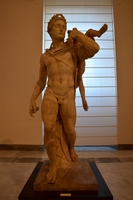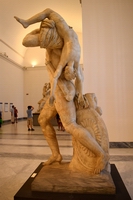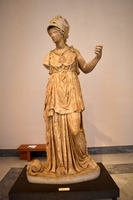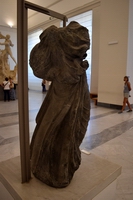MANN - Piano Terra - Collezione Farnese - sala XV
Posiziona il mouse sulle immagini per avere più informazioni

cd. Achille e Troilo
|

cd. Achille e Troilo
|

Minerva
|

Nike
|
Guerriero con fanciullo cd. Achille e Troilo
inv. 5999 Creazione romana, fine II-inizi III secolo d.C.
Il gruppo riproduce un soggetto di difficile esegesi: un guerriero in atto di sollevare o scagliare un fanciullo morente, afferrato per un piede. Le proposte di interpretazione oscillano tra Neottolemo con il cadavere di Astianatte o Achille con il corpo di Troilo. L'integrazione cinquecentesca ha conferito all'eroe il volto dell'imperatore Commodo (180-192 d.C.), di cui le fonti antiche ricordano la crudeltà. I restauri hanno profondamente alterato lo schema compositivo, secondo cui l'eroe sorreggeva il fanciullo per la gamba sinistra, come sembra documentare un frammento - rinvenuto nelle Terme nel 1901 - simile per dimensioni e tipo di lavorazione. Il gruppo era, forse, collocato nel frigidarium delle Terme. Dopo la scoperta, fu collocato nel primo cortile di Palazzo Farnese. Trasportato a Napoli nel 1787, fu destinato a decorare la nuova Villa di Chiaia da cui, nel 1826, fu rimosso e immesso nelle collezioni del Museo. È databile tra la fine del II e gli inizi del III secolo d.C.
Warrior with child (Achilles and Troilus)
inv. 5999 Roman creation, end 2nd-early 3 rd centuries AD
The identifìcation of this group is problematic. A warrior is depicted in the act of lifting or hurling a dying child, who is held by the foot. The interpretations vary in identifying the figures as Neoptolemus with the body of Astyanax, or as Achilles with the body of Troilus. Modifications in the 16th century gave the hero the face of the emperor Commodus (AD 180-192), whose cruelty was recorded by ancient sources. These changes altered profoundly the composition of the work, in which the hero lifted the boy by the left leg. A fragment of similar size and workmanship found in the Baths m 1901 appears to confirm this. The group may have been located in the frigidarium of the Baths. Following its discovery it was placed in the first courtyard of the Palazzo Farnese. Taken to Naples in 1787 it was set up in the new Villa Chiaia. It was removed from there in 1826 and placed in the Museum collections. It can be dated between the end of the 2nd and beginning of the 3rd century AD.
Minerva
inv. 6319 Creazione romana, II secolo d.C., da originale greco di età classica.
La statua è una rielaborazione di un tipo statuario classico risalente alla seconda metà del V sec. A.C.. La dea è raffigurata con l'elmo corinzio in posa meditativa. Originariamente sosteneva con la destra lo scudo poggiato al suolo ed impugnava nella sinistra la lancia. Sono di restauro la testa e le braccia, una delle quali è perduta. A Palazzo Farnese era collocata in una delle due nicchie del Gran Salone. La scultura è databile al II sec. d.C.
Minerva
inv. 6319 Roman creation, 2nd century AD, from a Greek original of classic period.
This statue is a reworking of a classical statue type of the second half of the 5th century BC. The goddess is depicted with a Corinthian helm in a pose of contemplation. Originally her right hand supported the shield that rested on the ground, and she grasped the spear in her left. The head and arms, one of which has been lost, are restorations. In the Palazzo Farnese the statue was located in one of the two niches of the Great Salon. The sculpture can be dated to the 2nd century AD.
Nike
inv. s.n. Copia romana, fine II-inizi III secolo d.C., da originale greco di età ellenistica.
La statua in bigio morato rappresenta la Vittoria con l'abito modellato dal vento, colta nell'attimo di poggiare il piede al suolo. Questo schema iconografico è stato creato in età ellenistica rielaborando un motivo di età classica ed è stato ampiamente utilizzato in età romana. La scultura è databile tra la fine del II e gli inizi del III sec. d.C. Le parti nude, eseguite separatamente, sono andate perdute, come quelle in marmo supplite dai restauratori cinquecenteschi. La statua fu commissionata per le Terme forse per fare coppia con una menade, dello stesso marmo, riutilizzata nell'edificio, e che si trova attualmente nel Museo archeologico di Palermo.
Nike
inv. s.n. Roman copy, end 2nd-early 3rd centuries AD, from a Greek original of ellenistic period.
This statue in bigio morato (fine grained grey marble) represents Victory, her dress swept by the wind, caught in the act of alighting with her foot on the ground. This iconographical scheme was created in the Hellenistic period by reworking a theme from the classical age, and was widely used in the Roman era. The sculpture can be dated to between the end of the 2nd century and beginning of the 3rd century AD. The nude parts were executed separately and have been lost, like those in marble supplied by the 16th century restorers. The statue was commissioned for the Baths, perhaps to be paired with a maenad made from the same marble that was reused in the building. Today the latter can be found in the Palermo archaeological museum.
Fotografie di Giorgio Manusakis






